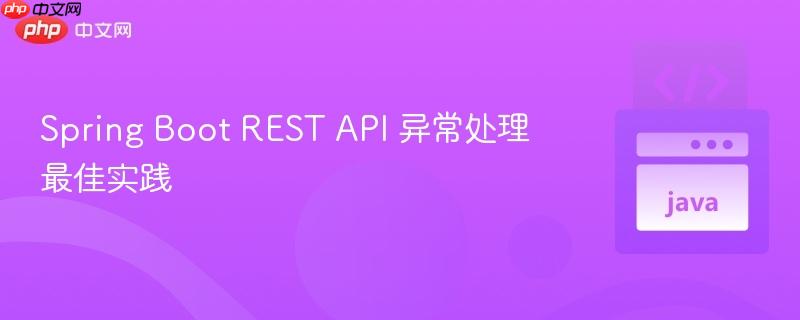
在spring boot应用中,尤其当与前端框架如angular集成时,推荐采用统一的rest api异常处理策略。核心思想是后端不进行页面重定向,而是返回结构化的json错误响应(如包含错误消息和错误码的`apierror`对象),并利用`@controlleradvice`实现全局异常捕获。前端根据接收到的错误响应进行相应的ui展示或导航。
在构建现代化的前后端分离应用时,后端API的异常处理机制对于提升用户体验和系统稳定性至关重要。传统的服务器端页面重定向已不再适用于RESTful API,因为前端框架(如Angular、React、Vue)需要通过API响应来感知错误并自主地进行视图渲染或导航。本文将深入探讨Spring Boot中处理REST API异常的最佳实践。
在单个控制器方法上使用@ResponseStatus和@ExceptionHandler注解可以处理特定的异常,例如:
@GetMapping("/{id}")
public ResponseEntity<Curse> getCursaById (@PathVariable("id") Long id) {
Curse c = curseService.findCurseById(id);
return new ResponseEntity<>(c, HttpStatus.OK);
}
@ResponseStatus(HttpStatus.NOT_FOUND)
@ExceptionHandler(CursaNotFoundException.class)
public String noCursaFound(CursaNotFoundException ex) {
return ex.getMessage();
}以及自定义异常类:
public class CursaNotFoundException extends RuntimeException {
public CursaNotFoundException(String s) {
super(s);
}
}这种方式的局限性在于:
为了克服上述局限性,推荐采用以下策略:
后端在发生异常时,应返回一个包含详细错误信息的结构化对象,通常是JSON格式。这使得前端能够清晰地解析错误类型、消息和可能的错误码。
public class ApiError {
private String message; // 错误消息
private String code; // 错误码,可用于前端进行特定处理
// 可以根据需要添加更多字段,例如:
// private HttpStatus status; // HTTP状态码
// private LocalDateTime timestamp; // 错误发生时间
// private String path; // 请求路径
public ApiError() {
}
public ApiError(String message, String code) {
this.message = message;
this.code = code;
}
// Getters and Setters
public String getMessage() {
return message;
}
public void setMessage(String message) {
this.message = message;
}
public String getCode() {
return code;
}
public void setCode(String code) {
this.code = code;
}
}@ControllerAdvice 注解允许您定义一个全局的异常处理器,捕获所有控制器抛出的特定类型异常。这极大地简化了异常处理逻辑,并确保了错误响应的统一性。
创建一个全局异常处理类:
import org.springframework.http.HttpStatus;
import org.springframework.http.ResponseEntity;
import org.springframework.web.bind.annotation.ControllerAdvice;
import org.springframework.web.bind.annotation.ExceptionHandler;
@ControllerAdvice
public class GlobalExceptionHandler {
/**
* 处理 CursaNotFoundException 异常
* 当 CursaNotFoundException 发生时,返回 HTTP 404 NOT_FOUND 状态码
* 和结构化的 ApiError 对象。
*/
@ExceptionHandler(value = CursaNotFoundException.class)
public ResponseEntity<ApiError> handleCursaNotFoundException(CursaNotFoundException ex) {
ApiError error = new ApiError();
error.setMessage(ex.getMessage());
// 假设 CursaNotFoundException 有一个 getCode() 方法
// 如果没有,可以硬编码一个错误码或从消息中提取
error.setCode("CURSA_NOT_FOUND"); // 或者 ex.getCode()
return new ResponseEntity<>(error, HttpStatus.NOT_FOUND);
}
/**
* 处理所有未被特定处理的 Exception 异常
* 这是一个通用的异常处理器,捕获所有其他类型的异常。
* 返回 HTTP 500 INTERNAL_SERVER_ERROR 状态码和通用的 ApiError 对象。
*/
@ExceptionHandler(value = Exception.class)
public ResponseEntity<ApiError> handleGenericException(Exception ex) {
ApiError error = new ApiError();
error.setMessage("An unexpected error occurred: " + ex.getMessage());
error.setCode("GENERIC_ERROR");
// 实际应用中,这里应该记录详细日志,但避免在响应中暴露敏感信息
return new ResponseEntity<>(error, HttpStatus.INTERNAL_SERVER_ERROR);
}
// 可以添加更多 @ExceptionHandler 方法来处理其他特定异常,例如:
// @ExceptionHandler(MethodArgumentNotValidException.class)
// public ResponseEntity<ApiError> handleValidationExceptions(MethodArgumentNotValidException ex) {
// // 处理验证失败异常,提取所有字段错误信息
// String errorMessage = ex.getBindingResult().getFieldErrors().stream()
// .map(error -> error.getField() + ": " + error.getDefaultMessage())
// .collect(Collectors.joining(", "));
// ApiError error = new ApiError(errorMessage, "VALIDATION_ERROR");
// return new ResponseEntity<>(error, HttpStatus.BAD_REQUEST);
// }
}在这个GlobalExceptionHandler中:
当后端按照上述方式返回结构化的ApiError响应时,前端(如Angular)可以通过HTTP客户端(如HttpClient)拦截这些错误响应:
import { Injectable } from '@angular/core';
import { HttpInterceptor, HttpRequest, HttpHandler, HttpEvent, HttpErrorResponse } from '@angular/common/http';
import { Observable, throwError } from 'rxjs';
import { catchError } from 'rxjs/operators';
import { Router } from '@angular/router';
@Injectable()
export class ErrorInterceptor implements HttpInterceptor {
constructor(private router: Router) {}
intercept(request: HttpRequest<any>, next: HttpHandler): Observable<HttpEvent<any>> {
return next.handle(request).pipe(
catchError((error: HttpErrorResponse) => {
let errorMessage = 'An unknown error occurred!';
let errorCode = 'UNKNOWN_ERROR';
if (error.error instanceof ErrorEvent) {
// 客户端或网络错误
errorMessage = `Error: ${error.error.message}`;
} else {
// 后端返回的错误
if (error.error && error.error.message) {
errorMessage = error.error.message;
errorCode = error.error.code || errorCode;
} else if (error.message) {
errorMessage = error.message;
}
switch (error.status) {
case 404:
// 资源未找到
console.error(`404 Not Found: ${errorMessage}`);
// 例如,可以重定向到自定义的404页面
this.router.navigate(['/not-found']);
break;
case 500:
// 服务器内部错误
console.error(`500 Internal Server Error: ${errorMessage}`);
// 例如,可以重定向到错误提示页面
this.router.navigate(['/error']);
break;
// 其他状态码处理
default:
console.error(`HTTP Error ${error.status}: ${errorMessage}`);
break;
}
}
// 将错误重新抛出,以便其他订阅者也能处理
return throwError(() => new Error(errorMessage));
})
);
}
}通过HTTP拦截器,前端可以统一处理所有API请求的错误,根据ApiError中的message和code来显示用户友好的提示信息,或者根据HTTP状态码和错误码进行页面重定向(例如,跳转到404页面或通用错误页面)。
在Spring Boot构建RESTful API时,采用@ControllerAdvice配合结构化ApiError响应的全局异常处理方案,是与前端框架(如Angular)良好协作的最佳实践。这种方法不仅实现了异常处理的统一管理,提高了代码的可维护性,还为前端提供了清晰、可消费的错误信息,从而提升了整个应用的健壮性和用户体验。通过前后端的紧密协作,可以构建出更加稳定和用户友好的应用。
以上就是Spring Boot REST API 异常处理最佳实践的详细内容,更多请关注php中文网其它相关文章!

每个人都需要一台速度更快、更稳定的 PC。随着时间的推移,垃圾文件、旧注册表数据和不必要的后台进程会占用资源并降低性能。幸运的是,许多工具可以让 Windows 保持平稳运行。

Copyright 2014-2025 https://www.php.cn/ All Rights Reserved | php.cn | 湘ICP备2023035733号